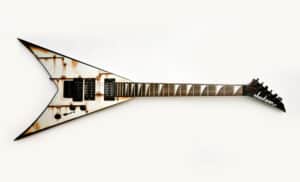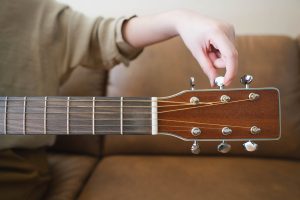
As a beginner, I was in the market for a new acoustic guitar, and I came across many options. Amongst them was the dreadnought guitar, which stood out in popularity and the rich history behind it, and the quality of its sound.
So what is a dreadnought guitar, and why is it so popular amongst guitar players and enthusiasts?
A dreadnought guitar is an acoustic guitar that is unique in its size as it is one of the largest guitar types. It was named after a large British battleship called HMS dreadnought in 1916 by Martin Guitars.
Dive with me into the history of the dreadnought guitar, what makes it stand out amongst other acoustic guitars, and what its drawbacks and variations are.
Brief Background History of Dreadnought Guitar
Dreadnought guitars are known for their unique design and simplicity. The shape of a dreadnought guitar is similar to a classical guitar, but their most significant difference is the dreadnought’s size.
The design can be dated back to 1916, when the dreadnought guitar was first introduced to the market by Martin Guitars. The first set of releases didn’t do well in the market, and it was subsequently abandoned.
However, in 1931, Martin began to release new dreadnought guitars, most notably the D2 models made of rosewood. The D2 model is the inspiration behind the modern dreadnought guitars of today.
The dreadnought guitar, as already stated, was named after a large British battleship that was launched in 1906. Since the dreadnought guitar is also large and sturdy, it is easy to see why it is named after the battleship.
Dreadnought guitars are pretty famous in bluegrass and folk music and are the defining tone of this respective music.
What Makes the Dreadnought Guitar Unique?
There are a few features that make the dreadnought guitar stand out above other acoustic guitars.
Full and Punchy Sounds
Acoustic guitars generally lack the volume and fullness of tone provided by electric guitars. However, dreadnought guitar tones are punchier than most acoustic guitars.
This is because a dreadnought guitar is larger than an average acoustic guitar. Its size allows for adequate airflow, giving the dreadnought guitar an increased volume with rich, warmer, and bolder tones.
Higher Notes
Compared to electric guitars, most acoustic guitars have an earlier neck cut-off than electric guitars. This means you can’t play higher and more interesting chords.
However, while still lagging behind electric guitars, the dreadnought guitar cuts off at the 14th fret, which is higher than other acoustic guitars. This implies that the dreadnought guitar can play some higher-up chords.
It also makes it suitable for playing higher solo songs.
Great Versatility
Dreadnought guitars are versatile in various ways. It can be used as a bass guitar due to its larger body size, enabling it to produce loud and punchy bass better than an average acoustic guitar.
Due to its long neck, it can also be used as a solo guitar and play interesting higher chords that can mostly be played on electric guitars.
Also, in terms of versatility, dreadnought guitars are great for rhythmic and percussive plays. They can be used to hold down a rhythm and to run percussions on songs with several singers.
Drawbacks of a Dreadnought Guitar

Dreadnought Guitar is one of the most popular acoustic guitars with more features than an average acoustic guitar. But it is not without its drawbacks.
While its big size confers a loud and rich tone, it can be uncomfortable for some guitar players to handle. So if you want to buy one, you might want to try it out in the store to see how comfortable it is for you to handle. Also, due to the big size, it can be uncomfortable to carry around.
Also, with the big size of the dreadnought guitar comes a loud and bold tone. So this can be a bit problematic when you are trying to have a practice session without making too much noise which can disturb your neighbors.
Dreadnought guitars have their strings made out of steel rather than nylon. This can pose a problem for beginners who might find steel strings painful to play.
But with time, as in the case of people who have played the dreadnought guitar for a long time, the fingertips of your fretting hand will adapt to the steel strings by forming calluses. This is meant to prevent your fingers from further injury when striking the steel strings.
Important Varieties of Dreadnought Guitars
While there are many brands of dreadnought guitars out there with different variations, here are the significant variations that you might find interesting.
Cutaway
While it has already been established that dreadnought guitars generally have higher frets compared to other acoustic guitars, the frets can further be increased with a cutaway. This can also be found on other acoustic guitars.
It is helpful for both rhythm and solo playing, but it is primarily a preferred option for lead guitarists who wish to use more of the fingerboard.
Acoustic-Electric Dreadnought Guitars
These are dreadnought guitars with electric components, and they can be connected to an amplifier or a public address system. These types are suitable for recording and other gigs. You can modify its tone using a mixer or amplifier.
Hybrid Dreadnought Guitars
These are the types of dreadnought guitars that not only have a cutaway but also have electric components built-in. They are pretty standard nowadays.
Take Away
Dreadnought guitars are one of the most commonly used guitars in the world. It’s a big-sized acoustic guitar which was named after a British battleship.
While the dreadnought guitar is an acoustic guitar, it differs from other acoustic guitars in its size and rich sound. The modern models also come in different variations.









